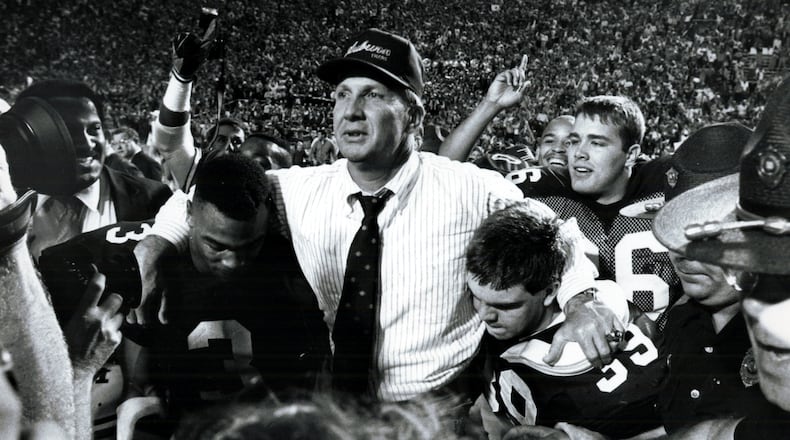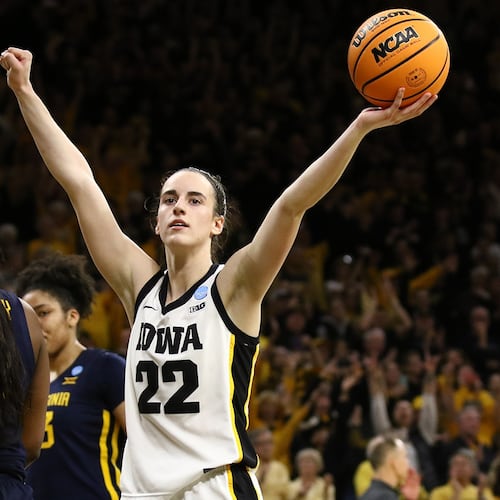Pat Dye took Auburn from Little Brother to Big Deal. The Tigers were Alabama’s rival long before he arrived, but they weren’t a source of continual worry. From 1959 through 1981, they beat Alabama four times in 23. But they won in 1982, Year 2 of Dye’s stewardship. Barely two weeks later, Bear Bryant announced his retirement.
He’d just lost to a former assistant, which was bad enough, but whispers held that Bryant, then 69, felt the wind of change. Bryant had grown accustomed to having his pick of the best recruits. (Before scholarship limitations were imposed, he’d sign guys just so he didn’t have to play against them.) The Bear wanted an offensive lineman from Birmingham. Ben Tamburello opted for Dye’s Auburn instead. There are those who insist that Bryant said, “If I can’t get Ben Tamburello, I need to hang it up” – or words to that effect.
Dye won the Iron Bowl four times in six seasons. Had he been a bit luckier – or a bit better tactician; the fourth-down try for a touchdown when a field goal would have put Auburn ahead with three minutes left in 1984 remains an all-time gaffe – his Tigers would have won all six. The 1989 game, the last of those six, changed Southern football forever. For the first time, imperial Alabama met Auburn not at Birmingham’s Legion Field but in the Loveliest Village.
Kid Brother had grown into a peer. (And, on that supercharged Saturday, was 10 points better than Bill Curry’s Crimson Tide, who’d arrived undefeated.)
The Pat Dye Era ended badly. Auburn ran afoul of NCAA investigators and landed on probation. (An Eric Ramsey tape recording constituted Exhibit A.) Dye resigned in 1992 in something approximating disgrace, though Auburn never treated him as persona non grata. In 2005, the school named the Jordan-Hare Stadium sod Pat Dye Field. Not many coaches who leave a program in disrepute are treated as respected elder statesmen, but Auburn’s esteem for his eradication of the Tigers’ longstanding inferiority complex trumped all.
Dye died Monday. He was 80. His Auburn tenure lasted but 12 years, but those years rearranged the dynamics of the state in which college football matters most. He brought great recruits to a smallish town. He dared to look King Crimson in the eye, and for once the Tide blinked. He wasn’t a wordsmith. He wasn’t an outsize character. He didn’t dazzle you with offense. He ran his beloved Wishbone and dared the opponent to match Auburn’s will. Some did, though not many.
Vince Dooley, a Mobile native and an Auburn grad, was able to handle Florida and Georgia Tech well enough, but Dooley’s Georgia lost five of its final six games against Auburn as coached by Dye, a Blythe, Ga., native and a Georgia All-American. The exception, in 1986, was enough of an indignation for the ascendant Tigers that water cannon were used to disperse celebrating Bulldog fans in the Jordan-Hare stands. (“Between the Hoses,” as the game immediately became known.) Oh, and Georgia’s starting quarterback hadn’t shown up, James Jackson being delayed at a funeral.
That, too, was part of the Dye signature. As good as his Auburn teams could be, they’d always lose a game they shouldn’t have. The 1983 Tigers – with Bo Jackson, Lionel James and Tommie Agee – were good enough to have been national champs, but a clanging September home loss to Texas left them No. 3 in the final Associated Press poll. No. 1 was Miami, which upset Nebraska in the Orange Bowl and jumped over Auburn, which won a halting Sugar Bowl against Michigan.
The 1984 Tigers began the season ranked No. 1 but started 0-2, losing to Miami in the Meadowlands and Texas in Austin. The next year Auburn was No. 1 by late September, whereupon it was thumped 38-20 by Tennessee. Jackson would win the Heisman; his last collegiate team would finish a pedestrian 8-4. Skeptics would note that Dooley had Herschel Walker for three years, winning three SEC titles and a national championship, while Dye had Jackson for 3 ½ years – the great back was hurt for much of 1984 – and won the SEC once.
There would be three more conference titles for Dye and Auburn, but only in 1983 did they finish in the AP top five. This was, it must be noted, at a time when the SEC had slipped in national eminence. Over Dye’s 12 seasons, only one SEC team – Alabama in 1992, his final year – wound up No. 1. This isn’t to say that Auburn under Dye was ever a pushover. It was never that. It had too many good players, too many tough guys. (Many of those tough guys helped Terry Bowden, Dye’s successor, go 11-0 in 1993. No championship was forthcoming then, either; the Tigers were on probation.)
Those of us looking from the outside view Dye’s legacy as complicated – he won big but not big enough, and he exited with the wolf at the door. Those living within Alabama boundaries regard him in simpler terms. He was a transformative figure in a state ruled by the Tide. He helped turn the Auburn-Alabama game into the sport’s greatest rivalry. He uprooted the Iron Bowl from Birmingham, which advertised itself as “the football capital of the South.” He dared to take on the Bear, his employer for eight years in Tuscaloosa, and he more than measured up.
About the Author
The Latest
Featured


